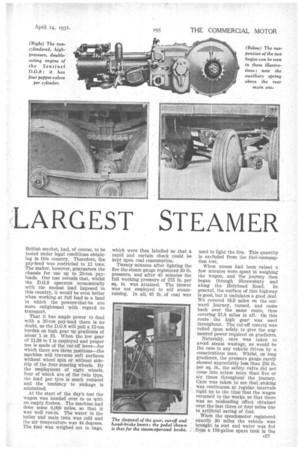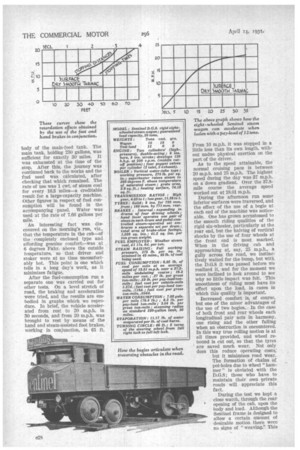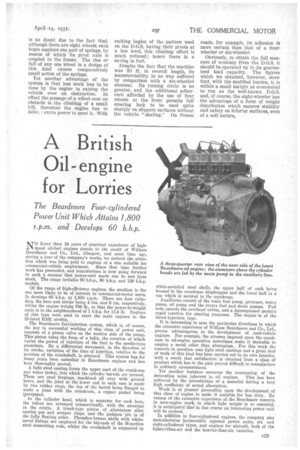jI Trial of
Page 48

Page 49

Page 50

Page 51

If you've noticed an error in this article please click here to report it so we can fix it.
BRITAIN LARGEST STEAMER
The Unique Sentinel D.G.8 Proves Its Power, Economy and 1VIanceuvrability. A Machine Well Suited to Arduous Service with Large Pay-loads. Marked Ability to Traverse Difficult Country
WHEN the Sentinel D.G.S—u. rigid eight-wheeler with a bogie at either end—was introduced last year by the Sentinel Waggon Works, Ltd., Shrewsbury, it aroused interest throughout the heavy-transport, industry. The novelty of employing ;our-wheel steering was, perhaps, at first .sight the most striking feature, but the student of transport units realzed the great value of even weight distribution and the additional steering adhesion,obtained by the ase of a second axle at the forward end.
This machine, which is the largestcapacity steam wagon*now on the British market, had, of course, to be tested under legal conditions obtaining in this country. Therefore, the pay-load was restricted to 12 tons. The maker, however, guarantees the chassis for use up to 20-ton payloads. Our test reveals that, whilst the D.G.8 operates economically with the modest load imposed in this country, it would be even better when working at full load in a land in which the powers-that-be are more enlightened with regard to transport.
That it has ample power to deal -with a 20-ton pay-load there is no doubt, as the D.G.8 will pull a 12-ton burden on high gear up gradients of about 1 in 10. When the low gear of 11.38 to 1 is employed and proper use is made of the cut-off lever—for Which there are three positions—the machine will traverse soft surfaces without wheel spin or without sideSlip of the four steering wheels. By the employment of eight wheels, four of which are of the twin type, the load per tyre is much reduced and the tendency to sinkage is minimized.
At the start of the day's test the wagon was handed over to us with an empty. firebox. The machine had done some 6,000 miles, so that it was well run-in. The water in the boiler and main tank was cold and the air temperature was 44 degrees. The fuel was weighed out in bags, which were then labelled so -that a rapid and certain check could be kept upon coal consumption.
Twenty minutes after lighting the fire the steam gauge registered 30 lb. pressure, and after 45 minutes the full working pressure of 275 lb. per sq. in. was attained. The blower was not employed to aid steamraising. In all, 85 lb. of -coal was used to light the fire. This quantity is excluded from the fuel-consumption test.
When steam had beenraised a few minutes were spent in weighing the wagon, and the journey then began through Shrewsbury and along the Holyhead Road. In general, the surface of this highway is good, but it undulates a good deal. We covered 18.9 miles on the outward journey, turned, and came back over the same route, thus covering 37.8 miles in all. On this route the high gear was used throughout. The cut-off control was -relied upon solely to givethe augmented power required on gradients.
Naturally, care was taken to avoid steam wastage, as would be .the case in any vehicle driven by a conscientious man. Whilst, on long gradients, the pressure gauge rarely showed appreciably less than 250 lb. per sq. in., the safety valve did not come into action more than five or six times throughoue the journey. Care was taken to.' see that stoking was continuous at regularintervals right up to the time that the wagon returned to the works, so that there was no misleading effect 'obtained over the last three-orfour-miles due to artificial saving of fuel.
When the speedometer registered exactly 30 miles the vehicle was brought to rest and water was fed from a 116-gallon spare tank in the body of the main-feed tank. The main tank, holding 230 gallons, was sufficient for exactly 30 miles. It was exhausted at the time of the stop. After this, the journey was continued back to the works and the fuel used was calculated, after checking that which remained. The rate of use was 1 cwt, of steam coal for every 16.3 miles—a creditable result for a large-capacity machine. Other figures in respect of .fuel consumption will be found in the accompanying panel. Water was used at the rate of 7.66 gallons per mile.
An interesting fact was discovered on the morning's run, viz., that the temperature in the cab—of the completely enclosed type and affording genuine comfort—was at 6 degrees Fahr. above the outside temperature, so that driver and stoker were at no time uncomfortably hot. This point is one which tells in a long day's work, as it minimizes fatigue.
After the fuel-consumption run a separate one was carried out for other tests. On a level stretch of road, the braking and acceleration were tried, and the results are embodied in graphs which we reproduce. In brief, the vehicle accelerated from rest to 20 m.p.h. in 30 seconds, and from 20 m.p.h. was brought to rest by means of the hand and steam-assisted foot brakes, working in conjunction, in 61 ft. From 10 m.p.h. it was stopped in a little less than its own length, without undue physical exertion on the part of the driver.
As to the speed attainable, the normal cruising pace is between 20 m.p.h. and 25 m.p.h. The highest speed during the day was 37 m.p.h. on a down gradient. Over the 37.8mile course the average speed worked out at 18.01 m.p.h.
During the afternoon run some inferior surfaces were traversed, and the effect of the use of a bogie at each end of the machine was noticeable. One has grown accustomed to the smooth riding qualities of the rigid six-wheeler, particularly at the rear end, but the halving of vertiCal shocks by the use of four wheels at the front end is most marked. When in the driving cab and approaching at, say, 25 m.p.h., a gully across the road, we instinctively waited for the bump, but with the D.G.8 it was passed before we realized it, and for the moment we were inclined to look around to see why so little impact was felt. This smoothness of riding must have its effect upon the load, in cases in which this quality is important.
Increased comfort is, of course, but one of the minor advantages of the use of two bogies. In the case of both front and rear wheels each longitudinal pair acts in harmony, one rising and the other falling when an obstruction is encountered. In this way true rolling motion is at all times provided, and wheel rebound is cut out, so that the tyres are saved much wear. Not only does this reduce operating costs, but it minimizes road wear. The formation of chains of pot-holes due to wheel " hammer " is obviated with the D.G.8; those who have to maintain their own private roads will appreciate this fact.
During the test we kept a close watch, through the rear opening of the cab, upon the body and load. Although the Sentinel frame is designed to allow a certain amount of desirable motion there were no signs of "weaving;'. This
is no doubt due to the fact that, although there are eight wheels, each bogie employs one pair of springs, by means of which its pivot axle is coupled to the frame. The rise or fall of any one wheel in a design of this kind causes comparatively small action of the springs.
Yet another advantage of the system is that less work has to be done by the engine in raising the vehicle over an obstruction. In effect the passage of a wlieel over an obstacle is the climbing of a small bill, therefore the engine has to deny,. : extra power to meet it. With rocking bogies of the pattern used on the D.G.8, having their pivots at a low level, this climbing effort is much reduced; hence there is a saving in fuel.
Despite the fact that the machine was 30 ft. in overall length, its manceuvrability in no way suffered by comparison with a six-wheeled steamer. Its turning circle is no greater, and the additional adherence afforded by the use of four wheels at the front permits full steering lock to be used quite sharply on slippery surfaces without the vehicle "skating." On frozen roads, for example, its adhesion is more certain than that of a fourwheeler or six-wheeler.
Obviously, to obtain the full measure of economy from the D.O.8, it should be. operated up to its guaranteed load capacity. The figures which we obtained, however, show that, with the modified burden, it is within a small margin as economical to run as the well-known D.G.6, and, of course, the eight-wheeler has the advantage of a form of weight distribution which ensures stability and safety on inferior surfaces, even of a soft nature.












































































































